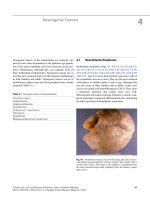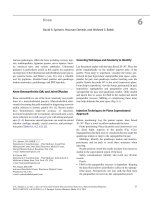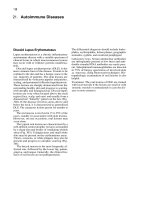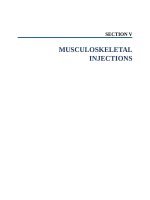Ebook Atlas of fetal MRI: Part 1
Bạn đang xem bản rút gọn của tài liệu. Xem và tải ngay bản đầy đủ của tài liệu tại đây (5.4 MB, 105 trang )
Atlas of
Fetal MRI
Atlas of
Fetal MRI
Edited by
Deborah Levine
Beth Israel Deaconess Medical Center
Harvard Medical School
Boston, Massachusetts, U.S.A.
Boca Raton London New York Singapore
Published in 2005 by
Taylor & Francis Group
6000 Broken Sound Parkway NW, Suite 300
Boca Raton, FL 33487-2742
© 2005 by Taylor & Francis Group, LLC
No claim to original U.S. Government works
Printed in the United States of America on acid-free paper
10 9 8 7 6 5 4 3 2 1
International Standard Book Number-10: 0-8247-2548-4 (Hardcover)
International Standard Book Number-13: 978-0-8247-2548-8 (Hardcover)
This book contains information obtained from authentic and highly regarded sources. Reprinted material is quoted with permission, and sources are
indicated. A wide variety of references are listed. Reasonable efforts have been made to publish reliable data and information, but the author and the
publisher cannot assume responsibility for the validity of all materials or for the consequences of their use.
No part of this book may be reprinted, reproduced, transmitted, or utilized in any form by any electronic, mechanical, or other means, now known
or hereafter invented, including photocopying, microfilming, and recording, or in any information storage or retrieval system, without written
permission from the publishers.
For permission to photocopy or use material electronically from this work, please access www.copyright.com ( or contact
the Copyright Clearance Center, Inc. (CCC) 222 Rosewood Drive, Danvers, MA 01923, 978-750-8400. CCC is a not-for-profit organization that
provides licenses and registration for a variety of users. For organizations that have been granted a photocopy license by the CCC, a separate system
of payment has been arranged.
Trademark Notice: Product or corporate names may be trademarks or registered trademarks, and are used only for identification and explanation
without intent to infringe.
Library of Congress Cataloging-in-Publication Data
Catalog record is available from the Library of Congress
Visit the Taylor & Francis Web site at
Taylor & Francis Group is the Academic Division of T&F Informa plc.
This book is dedicated to Alexander, Rebecca, and Julia Jesurum
Preface
Fetal magnetic resonance (MR) imaging has undergone a remarkable growth in the past decade. Fast imaging techniques
allow for images to be obtained in a fraction of a second. With this ability, we have begun to view the fetus in a manner not
previously possible. Although the appearance of fetal anatomy on sonography has been well-established, there are few
resources available that illustrate the MR appearance of normal and abnormal fetal anatomy.
Although ultrasound is the standard imaging technique utilized in pregnancy, there are many cases where sonographic
diagnosis is unclear. In these cases, MR imaging can help clarify diagnosis and thus aid in patient counseling and management. This is especially important in evaluation of the fetal central nervous system.
Knowledge of brain anatomy used for pediatric or adult imaging may not be sufficient for evaluation of the fetus, where,
for the brain in particular, changes in appearance occur over time. Abnormalities with a particular differential diagnosis in
pediatric patients can have a different differential diagnosis in the fetus. As interpretation of MR examinations may be
performed by radiologists, obstetricians, and pediatric subspecialists, it is important to have a text that incorporates
fetus-specific information needed by all of these subspecialties.
The illustrations in this text were taken from patients undergoing MR examinations for maternal and fetal indications.
Many of the studies were obtained under research protocols investigating the utility of fetal MR imaging.
There are many excellent textbooks of fetal anomalies. This book is not intended to replace them, rather, it is a resource
to illustrate the changing appearance of fetal anatomy over time and the types of anomalies that can be seen with fetal MR
imaging.
In addition to chapters that deal with normal anatomy and pathology, there are chapters with background information on
safety of MR in pregnancy, techniques of fast imaging, and artifacts.
I hope that this book will give prenatal diagnosticians an improved ability to counsel patients.
Deborah Levine
v
Acknowledgments
Many of the images of the fetal brain were obtained under NIH grant NS37945 and NIBIB EB001998. I am very grateful to
Dr. Herbert Kressel who encouraged my pursuit of fetal magnetic resonance imaging.
This work on fetal imaging would not have been possible without the training I received in Ultrasound. I feel very lucky
to have had as mentors: Barbara Gosink, Dolores Pretorius, George Leopold, Nancy Budorick, Roy Filly, Peter Callen,
Ruth Goldstein, and Vickie Feldstein.
The fetal research program at BIDMC would not have been possible without the support of the MR section chiefs,
Robert Edelman and Neil Rofsky who allowed use of the research magnet and shared their ideas on fast imaging sequences.
Special thanks go to the physicists who aided in sequence optimization, Qun Chen and Charles McKenzie. I am also very
grateful to the many technologists who helped scan patients, in particular Wei Li, Steven Wolff, and Norman Farrar. I would
like to thank Ronald Kukla for his administrative support.
I especially would like to thank the many proof-readers of the book chapters, including Alex Jesurum, Daniel Levine,
Dolores Pretorius, Philip Boiselle, and Donna Wolfe.
vii
Contents
Preface . . . . . . . . . . . . . . . . . . . . . . . . . . . . . . . . . . . . . . . . . . . . . . . . . . . . . . . . . . . . . . . . . . . . . . . . . . . . . . .
Acknowledgments
v
.......................................................................
vii
Contributors . . . . . . . . . . . . . . . . . . . . . . . . . . . . . . . . . . . . . . . . . . . . . . . . . . . . . . . . . . . . . . . . . . . . . . . . . . .
xi
1.
Safety of MR Imaging in Pregnancy
Deborah Levine
2.
MR Imaging of Normal Brain in the Second and Third Trimesters
Deborah Levine, Caroline Robson
...............................
7
3.
MR Imaging of Fetal CNS Abnormalities . . . . . . . . . . . . . . . . . . . . . . . . . . . . . . . . . . . . . . . . . . . . . . . . . .
Deborah Levine, Patrick Barnes
25
4.
MR Imaging of the Fetal Skull, Face, and Neck . . . . . . . . . . . . . . . . . . . . . . . . . . . . . . . . . . . . . . . . . . . . .
Annemarie Stroustrup Smith, Deborah Levine
73
5.
MR Imaging of Fetal Thoracic Abnormalities . . . . . . . . . . . . . . . . . . . . . . . . . . . . . . . . . . . . . . . . . . . . . . .
Deborah Levine
91
6.
MR Imaging of the Fetal Abdomen and Pelvis . . . . . . . . . . . . . . . . . . . . . . . . . . . . . . . . . . . . . . . . . . . . . . 113
Vandana Dialani, Tejas Mehta, Deborah Levine
7.
MR Imaging of the Fetal Extremities, Spine, and Spinal Cord . . . . . . . . . . . . . . . . . . . . . . . . . . . . . . . . . . . 139
Deborah Levine, Tejas Mehta
8.
MR Imaging of Multiple Gestations . . . . . . . . . . . . . . . . . . . . . . . . . . . . . . . . . . . . . . . . . . . . . . . . . . . . . . 163
Deborah Levine
9.
Current Techniques and Future Directions for Fetal MR Imaging
Charles A. McKenzie, Deborah Levine
. . . . . . . . . . . . . . . . . . . . . . . . . . . . . . . . 175
10.
MR Imaging Before Fetal Surgery: Contribution to Management
Bonnie N. Joe, Fergus V. Coakley
. . . . . . . . . . . . . . . . . . . . . . . . . . . . . . . . 193
11.
MR Imaging of the Maternal Abdomen and Pelvis in Pregnancy . . . . . . . . . . . . . . . . . . . . . . . . . . . . . . . . . 201
Deborah Levine, Ivan Pedrosa
Index
.....................................................
1
. . . . . . . . . . . . . . . . . . . . . . . . . . . . . . . . . . . . . . . . . . . . . . . . . . . . . . . . . . . . . . . . . . . . . . . . . . . . . . . . 231
ix
Contributors
Patrick Barnes, MD Department of Radiology, Lucille Salter Packard Children’s Hospital, Stanford University, Palo
Alto, California, USA
Fergus V. Coakley, MD
Department of Radiology, University of California, San Francisco, California, USA
Vandana Dialani, MD Department of Radiology, Beth Israel Deaconess Medical Center, Harvard Medical School,
Boston, Massachusetts, USA
Bonnie N. Joe, MD
Department of Radiology, University of California, San Francisco, California, USA
Deborah Levine, MD Department of Radiology, Beth Israel Deaconess Medical Center, Harvard Medical School,
Boston, Massachusetts, USA
Charles A. McKenzie, PhD Department of Radiology, Beth Israel Deaconess Medical Center, Harvard Medical School,
Boston, Massachusetts, USA
Tejas Mehta, MD Department of Radiology, Beth Israel Deaconess Medical Center, Harvard Medical School, Boston,
Massachusetts, USA
Ivan Pedrosa, MD Department of Radiology, Beth Israel Deaconess Medical Center, Harvard Medical School, Boston,
Massachusetts, USA
Caroline Robson, MB, ChB
Massachusetts, USA
Department of Radiology, Childrens Hospital, Harvard Medical School, Boston,
Annemarie Stroustrup Smith, MD
School, Boston, Massachusetts, USA
Harvard-MIT Division of Health Science and Technology and Harvard Medical
xi
1
Safety of MR Imaging in Pregnancy
DEBORAH LEVINE
TEMPERATURE INCREASES DURING
MR IMAGING
INTRODUCTION
The risks and benefits of all imaging studies that are
carried out during pregnancy need to be discussed with
the patient. In the case of magnetic resonance (MR)
imaging there are theoretical risks of teratogenicity, but
no proven effects in humans. This chapter reviews safety
concerns pertaining to MR examinations during pregnancy and illustrates embryonic and fetal anatomy in the
first trimester in examinations performed for maternal
indications.
Exposure of patients to MR imaging can produce heat
related to the radiofrequency pulses. Fluids, such as in
the lens of the eye, are known to be relatively poor in
dissipating deposited heat (12). As the fetus essentially
lies in a water bath, and because tissues dissipate heat
by blood flow, it is possible that heat accumulates in
the gravid uterus during medical imaging. The reason
why this is of particular concern in pregnant patients is
that the specific absorption rate (SAR) monitor, that documents the amount of energy deposited over time, is set for
the weight of the patient. However, when performing fetal
MR imaging we are actually studying a much smaller
patient (the fetus) in a highly conductive “salt-water”
bath (amniotic fluid). In addition, the gravid uterus in
the third trimester often fills the magnet bore: this limits
the amount of air-flow through the bore and around the
patient, thus potentially decreasing the ability of the
patient to radiate deposited heat to the environment.
Although body temperature has been shown to rise
during MR imaging at high whole-body SARs (13), in a
study using 4.0 W/kg on pregnant patients at 33– 39
weeks gestational age, no maternal temperature changes
were identified (14). In a study of measuring temperature
of amniotic fluid, fetal brain, and fetal abdomen in pregnant pigs, no temperature changes were noted using fast
MR imaging techniques (specifically half Fourier single
shot turbo spin-echo sequences) (15).
LITERATURE REGARDING POTENTIAL
TERATOGENIC EFFECTS
There is no consistent or convincing evidence to suggest
that short-term exposure to electromagnetic fields, such
as that which occurs during MR imaging, harms the developing fetus (1 – 5). A few studies have linked prolonged or
high-level electromagnetic field exposure to deleterious
effects on embryogenesis, chromosomal structure, or
fetal development (1,6 –10). However, in humans who
have been exposed to diagnostic MR imaging, no delayed
sequelae have been encountered, and it is expected that the
potential risk for any delayed sequelae is extremely small
or nonexistent. In a study by Myers et al. (11), no increased
incidence of growth retardation was observed in follow-up
of 74 pregnancies that had been exposed to in utero MR
echoplanar imaging.
1
2
NOISE DURING MR IMAGING
The amount of noise generated during fetal MR imaging is
also of potential concern. A model of sound wave transmission of a plane-wave sound across an air –water interface predicts a reduction in sound intensity of almost
30 dB in water (16). Using a fluid-filled stomach as a
model for the gravid uterus, Glover et al. (16) demonstrated that the attenuation of the sound intensity is .30 dB at
the frequencies generated during echoplanar imaging.
Much higher peak pressures could be obtained by
tapping the abdomen with the fingers. In a study of 25 children aged 2 –4 years born after having been scanned by
echoplanar imaging during pregnancy, there were no
reported cases of hearing damage or abnormalities (17).
FETAL HEART RATE DURING
MR IMAGING
A few in studies have assessed the potential effect of MR
procedures on fetal heart rate and motion (18,19). In a
study of fetal cardiotopography during MR imaging,
maternal temperature, heart rate, and blood pressure, as
well as fetal heart rate and motion, were measured in
eight women at 33 – 39 weeks gestational age before,
during, and after MR imaging at 1.5 T. No short-term
effects were detected (14).
CONTRAINDICATIONS TO MR IMAGING
AND PATIENT COMFORT
As for all patients, there are absolute contraindications to
MR imaging in pregnant patients (e.g., a ferromagnetic
cerebral aneurysm clip, cardiac pacemaker), and some
patients are too claustrophobic to undergo the examination. Use of short bore magnets makes claustrophobia
less of a concern. However, in patients who have a
history of claustrophobia, we have found it helpful to premedicate with sublingual Xanax 0.5 –3 mg given 1 hour
prior to the examination. In addition, for patients who
are claustrophobic but do not want to be medicated, we
have found it helpful to cover the eyes before the patient
enters the magnet bore. An additional problem in scanning
pregnant patients is that they may have difficulty lying on
their backs, especially in the third trimester. In these cases,
patients can be imaged in the lateral decubitus position.
INTRAVENOUS CONTRAST
Use of intravenous contrast for MR imaging is relatively
contraindicated in pregnancy. Gadolinium is a pregnancy
Category C drug, meaning that there are insufficient
studies to determine potential harmful effects in pregnant
Atlas of Fetal MRI
women. The drug should be used only if the benefit justifies
the potential risk to the fetus. The product insert for Magnevist (gadopentetate dimeglumine) states that gadopentetate dimeglumine slightly retarded fetal development when
given intravenously for 10 consecutive days to pregnant
rats at daily doses of 2.5 times the human dose and when
given intravenously for 13 consecutive days to pregnant
rabbits at daily doses of 7.5 times the human dose (20).
The Omniscan (Gadodiamide) insert states that Omniscan
has been shown to have an adverse effect on embryofetal development in rabbits that is observed as an
increased incidence of flexed appendages and skeletal malformations at dosages as low as 0.5 mmol/kg per day for
13 days during gestation (approximately two times the
maximum human cumulative dose of 0.3 mmol/kg) (21).
Therefore, at the current time, for fetal imaging there are
no accepted indications for use of intravenous contrast.
For assessment of maternal anatomy, the risk-benefit
ratio must be assessed on an individual basis.
IMAGING IN THE FIRST TRIMESTER
Because the greatest theoretic risk is at the time of organogenesis, and the small size of the developing fetus/embryo
is difficult to evaluate early in pregnancy, we avoid MR
imaging in the first trimester whenever feasible. With currently available techniques, it is not useful to perform MR
examinations for fetal diagnosis in the first trimester.
Figures 1.1 – 1.4 demonstrate first trimester pregnancies
scanned for maternal indications. As shown in these
figures, prior to 13 weeks the developing embryo/fetus
is small and difficult to adequately visualize. Anomalies
are better detected with ultrasound than with MR
imaging during this time period. However, MR imaging
can be useful when more information about the location
of a presumed abnormal gestational sac is needed
(Fig. 1.5). If MR imaging is needed for maternal diagnosis
in the first trimester, then imaging should be performed. In
a recent article by Shellock and Crues (22), it is stated that
“. . . in cases where the referring physician and the attending radiologist can defend that the findings of the MR procedure have the potential to affect the care of the mother or
fetus . . . the MR procedure may be performed with oral and
written informed consent, regardless of the trimester.”
SUMMARY OF RECOMMENDATIONS
According to the Safety Committee of the Society for
Imaging (23), MR procedures are indicated for use in pregnant women if other nonionizing forms of diagnostic
imaging are inadequate or if the examination provides
important information that would otherwise require
exposure to ionizing radiation (i.e., X-ray, CT, etc.). It is
required that pregnant patients be informed that, to
Safety of MR Imaging in Pregnancy
Figure 1.1 Uterus at 7 weeks gestational age. This representative sagittal T2-weighted image shows fluid in the intrauterine
gestational sac (S). The embryonic pole is not visualized on
this or other images obtained during the study owing to partial
volume averaging. B, bladder.
Figure 1.3 Fetus at 11 weeks gestational age. (a) Oblique sagittal view of fetal torso, arm (arrow), and leg (arrowhead). (b) Axial
view of fetal head. The intracranial anatomy is poorly visualized
secondary to partial volume averaging and early gestational age.
3
Figure 1.2 Embryo at 9 weeks gestational age. Sagittal
T2-weighted image of the uterus showing a coronal image of
embryonic torso. Owing to the small size of the embryo
(arrow), it is difficult to visualize anatomic structures.
Figure 1.4 Fetus at 13 weeks gestational age. (a) Oblique
coronal T2-weighted image of fetal torso shows the liver (L)
and the arm (arrow). (b) Oblique coronal view of fetal head
shows the cerebral ventricles (v). Note the improvement in
visualization of intracranial anatomy compared with Fig. 1.3.
4
Atlas of Fetal MRI
REFERENCES
1.
2.
3.
4.
5.
6.
7.
8.
9.
Figure 1.5 Pregnancy in myomectomy scar at 8 weeks gestational age. (a) Coronal and (b) sagittal T2-weighted images show
the gestational sac high in the left fundus, separate from the endometrial cavity (arrowheads). The placenta is seen extending into
the myometrium to the uterine serosa (arrow). This is the region
of the patient’s prior myomectomy. The patient was treated with
methotrexate.
date, although there is no indication that the use of clinical
MR procedures during pregnancy produces deleterious
effects, according to the FDA, the safety of MR procedures
during pregnancy has not been definitively proven (24).
According to the American College of Radiology
White Paper on MR Safety, “Pregnant patients can be
accepted to undergo MR scans at any stage of pregnancy
if, in the determination of a . . . designated attending radiologist, the risk– benefit ratio to the patient warrants that
the study be performed” (25). The White Paper further
states that “it is recommended that pregnant patients
undergoing an MR examination provide written informed
consent to document that they understand the risk/benefits
of the MR procedure to be performed, the alternative
diagnostic options available to them (if any), and that
they wish to proceed” (25).
10.
11.
12.
13.
14.
15.
16.
17.
Elster AD. Does MR imaging have any known effects on
the developing fetus? Am J Roentgenol 1994; 162:1493.
Geard CR, Osmak RS, Hall EJ et al. Magnetic resonance
and ionizing radiation: a comparative evaluation in vitro
of oncogenic and genotoxic potential. Radiology 1984;
152:199 –202.
Kay HH, Herfkens RJ, Kay BK. Effect of magnetic resonance imaging on Xenopus laevis embryogenesis. Magn
Reson Imaging 1988; 6:501 –506.
Peeling J, Lewis JS, Samoiloff M et al. Biological effects of
magnetic fields: chronic exposure of the nematode Panagrellus redivivus. Magn Reson Imaging 1988; 6:655 –660.
Prasad N, Wright DA, Ford JJ et al. Safety of 4-T MR
imaging: study of effects on developing frog embryos.
Radiology 1990; 174:251 – 253.
Beers GJ. Biological effects of weak electromagnetic fields
from 0 Hz to 200 MHz: a survey of the literature with
special emphasis on possible magnetic resonance effects.
Magn Reson Imaging 1989; 7:309 – 331.
Carnes KI, Magin RL. Effects of in utero exposure to 4.7 T
MR imaging conditions on fetal growth and testicular
development in the mouse. Magn Reson Imaging 1996;
14:263– 274.
Heinrichs WL, Fong P, Flannery M et al. Midgestational
exposure of pregnant BALB/c mice to magnetic resonance
imaging conditions. Magn Reson Imaging 1988;
6:305– 313.
Tyndall DA, Sulik KK. Effects of magnetic resonance
imaging on eye development in the C57BL/6J mouse.
Teratology 1991; 43:263 – 275.
Yip YP, Capriotti C, Talagala SL et al. Effects of MR
exposure at 1.5 T on early embryonic development of the
chick. J Magn Reson Imaging 1994; 4:742 –748.
Myers C, Duncan KR, Gowland PA et al. Failure to detect
intrauterine growth restriction following in utero exposure
to MRI. Br J Radiol 1998; 71:549– 551.
Shellock FG, Crues JV. Corneal temperature changes
induced by high-field-strength MR imaging with a head
coil. Radiology 1988; 167:809– 811.
Shellock FG, Schaefer DJ, Kanal E. Physiologic responses to an MR imaging procedure performed at a
specific absorption rate of 6.0 W/kg. Radiology 1994;
192:865 –868.
Michel SC, Rake A, Keller TM et al. Fetal cardiographic
monitoring during 1.5-T MR imaging. Am J Roentgenol
2003; 180:1159 – 1164.
Levine D, Zuo C, Faro CB et al. Potential heating effect in
the gravid uterus during MR HASTE imaging. J Magn
Reson Imaging 2001; 13:856 –861.
Glover P, Hykin J, Gowland P et al. An assessment of the
intrauterine sound intensity level during obstetric echoplanar magnetic resonance imaging. Br J Radiol 1995;
68:1090 –1094.
Baker PN, Johnson IR, Harvey PR et al. A three-year followup of children imaged in utero with echo-planar magnetic
resonance. Am J Obstet Gynecol 1994; 170:32–33.
Safety of MR Imaging in Pregnancy
18.
19.
20.
21.
22.
Poutamo J, Partanen K, Vanninen R et al. MRI does not
change fetal cardiotocographic parameters. Prenat Diagn
1998; 18:1149 –1154.
Vadeyar SH, Moore RJ, Strachan BK et al. Effect of fetal
magnetic resonance imaging on fetal heart rate patterns.
Am J Obstet Gynecol 2000; 182:666 – 669.
Product Information, Magnevist, Berlex Laboratories, 2000.
Product Information, Omniscan, Amersham Health, 2000.
Shellock FG, Crues JV. MR procedures: biologic effects,
safety, and patient care. Radiology 2004; 232:635 –652.
5
23.
24.
25.
Shellock FG, Kanal E. Policies, guidelines, and recommendations for MR imaging safety and patient management.
SMRI Safety Committee. J Magn Reson Imaging 1991;
1:97– 101.
US Food and Drug Administration. Guidance for content
and review of a magnetic resonance diagnostic device
510 (k) application. Washington DC, Aug 2, 1988.
Kanal E, Borgstede JP, Barkovich AJ et al. American
College of Radiology White Paper on MR Safety. Am J
Roentgenol 2000; 178:1335– 1347.
2
MR Imaging of Normal Brain in the Second and Third Trimesters
DEBORAH LEVINE, CAROLINE ROBSON
INTRODUCTION
guidelines provided by Chi et al. (8) describe gestational
ages at which 25 – 50% of brain specimens demonstrate
particular cortical landmarks, with an interval of $2
weeks between the earliest appearance of a particular
landmark and its occurrence in 75– 100% of the brains
(8). Magnetic resonance maturation appears slightly
delayed relative to neuroanatomic studies due to various
factors: (1) neuroanatomic studies being performed on
thin slices being directly visualized; (2) MR slice thickness
(3 – 5 mm) being much greater than that used in the anatomic studies (15 – 30 mm); (3) image quality issues such
as suboptimal signal-to-noise; and (4) limited spatial resolution compared with neuroanatomic studies.
Normal cortical development in the second and third
trimesters is illustrated in Figs. 2.1 –2.14, which are
presented in order of gestational age. In general, fetuses
with mild ventriculomegaly and other CNS anomalies
have delayed cortical development as compared with
normal fetuses (Table 2.2) (6).
One of the best-accepted applications of fetal magnetic resonance (MR) imaging is assessment of the central nervous
system (CNS) (1–5). The anatomic detail provided by MR
imaging allows for direct visualization of the brain parenchyma, which can aid in the diagnosis of CNS abnormalities.
The changing appearance of the brain throughout gestation
can make assessment of abnormalities challenging; thus, it
is helpful to have a frame of reference for the normal
appearance of anatomy over time. In particular, knowledge
of the normal appearance and maturation of the developing
sulci and gyri is helpful in the appropriate diagnosis and
counseling of anomalous fetuses in whom cortical development may be delayed or altered. There are no accepted indications for fetal MR imaging in the first trimester; therefore
this chapter details the developmental changes that are
observable from 14 weeks gestational age and beyond.
CORTICAL DEVELOPMENT—
AN OVERVIEW
Second Trimester
Cortical maturation, as manifested by the progressive
appearance, deepening, and increasing complexity of
cerebral sulci, is clearly demonstrated by fetal MR imaging.
However, normal maturation as visualized on MR examinations follows a predictable course that lags behind the
time sequence for maturation described in neuroanatomic
specimens (6,7). Table 2.1 reviews the appearance of sulci
in normal fetuses with respect to gestational age in neuroanatomic (8) and MR studies (6,7). The neuroanatomic
At 14 weeks, the cerebral convexities are smooth. The
ventricles occupy most of the cerebral hemispheres. The
choroid plexus, which is well visualized sonographically
as an echogenic structure filling the cerebral ventricles,
is not well visualized on MR imaging (Fig. 2.1). A thin
rim of smooth parenchyma is present. The interhemispheric fissure separating the cerebral hemispheres is
well-developed.
7
8
Table 2.1
Atlas of Fetal MRI
Reported Appearance of Sulci with Respect to Gestational Age
Detectable
Detectable
Detectable
Detectable
in .75% of
in 25 – 75% of
Neuropathologic in 25 – 75% of in .75% of
brains in study
brains in study brains in study brains in study
appearance
by Levine (6) by Levine (6) by Garel et al. (7) by Garel et al. (7)
in 25– 50% of
(weeks)
(weeks)
(weeks)
(weeks)
brains (8)a (weeks)
Sulci/fissures of the medial cerebral surface
Interhemispheric
Parietoocipital
Cingulate
Secondary cingular
Calcarine
Secondary occipital
10
16
18
32
16
34
—
—
24 – 25
—
—
10b
18 – 19
26 – 27
—
18 – 19
—
—
22 –23c
31
22 –23c
32
—
—
24– 25
33
24– 25
34
Sulci of the ventral surface
Collateral
Occipitotemporal
23
30
—
—
—
—
24 –25
29
27
33
Sulci of the lateral surface
Sylvian
Parietooccipital
Circular
Superior frontal
Inferior frontal
Superior temporal
Inferior temporal
Interparietal
Insular
Secondary Frontal
Secondary Temporal
Secondary Parietal
Superior occipital
Inferior occipital
Tertiary Frontal
14
16
18
25
28
23
30
26
34
32
36
33
34
34
40
—
—
—
—
30 – 31
26 – 27
28 – 29
—
30 – 31
32 – 33
32 – 33
—
34 – 35
34 – 35
38 – 39
16 – 17
18 – 19
18 – 19
—
34 – 35
28 – 29
32 – 33
—
32 – 33
34 – 35
34 – 35
34 – 35
36 – 37
—
—
—
—
—
24 –25
26
26
30
27
33
—
—
—
—
—
—
—
—
—
29
29
27
33
28
34
—
—
—
—
—
—
Sulci of the vertex
Central
Precentral
Postcentral
20
24
25
—
—
26 – 27
26 – 27
26 – 27
28 – 29
24 –25
26
27
27
27
28
a
This article describes the $2 week interval between when a sulcus is seen in 25–50% and when it is seen in 75–100% of fetuses.
Unreported data.
c
The earliest gestational age studied in this study was 22 weeks.
b
At 16 weeks, the Sylvian fissure is visualized as a
shallow concavity or groove along the lateral convexity.
The Sylvian fissure deepens over time, becoming more
angular as the frontal and temporal opercula form
(Fig. 2.6). The parietooccipital and calcarine fissures, on
anatomic specimens, are seen at $16 weeks gestational
age. They are generally observed on MR examinations
by 20 –22 weeks (Fig. 2.4).
The callosal sulcus separates the corpus callosum and
overlying cingulate gyrus, which is seen at $18 weeks
(Fig. 2.2). The central sulcus appears on the superior
parasagittal aspect of the cortex at 20 weeks gestation
in anatomic specimens. Although the central sulcus has
been observed on MR images as early as 22 weeks, it
is not reliably seen until 24 – 25 weeks gestation
(Fig. 2.5).
At 22 weeks, the lateral hemispheres are smooth and
the insulae are wide open (Fig. 2.4). The temporal lobe
remains smooth until $23 weeks. The precentral and postcentral gyri appear at $26 weeks (Fig. 2.6), first as shallow
grooves that deepen as gestational age progresses.
On T2-weighted imaging, three distinct layers are seen
comprising cerebral parenchyma (Fig. 2.2) (9). The innermost layer is of low signal intensity and corresponds to the
germinal matrix. The middle region is of intermediate
signal intensity and corresponds to a less cellular region
of developing white matter; and the outermost hypointense
layer corresponds to the developing cortex.
Normal Brain in the Second and Third Trimesters
9
Figure 2.1 Normal anatomy on T2-weighted images at 14 weeks gestational age. Axial image (a) shows the posterior fossa containing
the developing cerebellar hemispheres (CH) and fourth ventricle (FV) with communication between the fourth ventricle and the cisterna
magna. Sequential coronal images (b– d) show the smooth cerebral hemispheres. The lateral ventricles (LV) are relatively prominent
compared with the brain parenchyma. In (b) the lateral ventricles occupy most of the parietal lobes. The diencephalon (Di) connects
the cerebral hemispheres with the brainstem. Image through the frontoparietal region (c) shows the interhemispheric fissure between
the lateral ventricles. The developing temporal lobe (TL) is visible on each side. The Sylvian fissure has not yet developed sufficiently
for visualization on MR imaging. Coronal image through the frontal lobes (d) reveals the frontal horns of the lateral ventricles. Inferolaterally, the developing globes are visible (arrowheads).
Third Trimester
By 28 –30 weeks, numerous new sulci and gyri develop
(Figs. 2.9 and 2.10). The insular cortex forms the base of
the Sylvian fissure and this region ultimately becomes
covered as the opercula develop and mature. As a result,
the Sylvian fissure narrows on parasagittal and coronal
images (Figs. 2.7– 2.13). On the parasagittal images, the
Sylvian fissure slopes slightly upwards from front to
back (Figs. 2.11 –2.13). The germinal matrix is much
less prominent, and the cortex is observed as having two
layers: the inner layer, which is of relatively high signal
intensity, and the outer layer with slightly lower signal
intensity (9).
By 32 –35 weeks, secondary sulci appear throughout
the cortex (Figs. 2.11 and 2.12). By term, tertiary sulci
have formed but are often poorly seen because of a relative
decrease in the contrast between white matter and the
overlying cortex, and a relative decrease in the amount
of extra-axial cerebrospinal fluid (Fig. 2.14).
T1-WEIGHTED IMAGING
T1-weighted imaging in fetal MR examinations is typically performed to assess blood products or fatty lesions.
Fetal motion frequently limits anatomic information due
to relatively long scan times. At 13 –14 weeks, the germinal matrix appears as a band of increased signal intensity
along the lateral ventricular wall (10). It has been reported
that at 16 – 18 weeks there are five distinct layers of signal
intensity that represent the innermost hyperintense germinal matrix; a hypointense band of developing white
matter; a hyperintense layer of migrating neuroblasts;
another hypointense layer of developing white matter;
and the outermost hyperintense cerebral cortex (10).
(text continued on page 20)
10
Atlas of Fetal MRI
Figure 2.2 Normal anatomy on T2-weighted images at 18 weeks gestational age. Parasagittal image (a) demonstrates the developing
frontal and temporal lobes containing the frontal horn (FH) and temporal horn (TH) of the lateral ventricle. Primitive fetal ventricular
morphology is seen. Notice the relatively prominent trigone of the lateral ventricle (TLV). Midline sagittal image (b) reveals the callosal
sulcus (CS) separating the corpus callosum below from the cingulate gyrus above. Axial image (c) through the posterior fossa reveals the
frontal (FL) and temporal lobes (TL) separated by the developing hypointense sphenoid ridge that separates the anterior cranial fossa from
each middle cranial fossa. Within the posterior fossa the developing cerebellum is well seen and the cerebellar hemisphere (CH) and
cerebellar vermis (CV) are indicated. The cisterna magna and cisterns around the cerebellum are relatively prominent at this stage of
development. A more cephalad axial image (d) reveals early development of the circular or Sylvian fissure (SF) separating the frontal
and temporal lobes. The hypointense germinal matrix (GM) is visible along the lateral aspect of the lateral ventricles. Coronal images
through the parietal lobes (e) and frontal lobes (f) reveal the hypointense cerebral cortex (Cx), relatively hyperintense white matter
(WM), and intermediate intensity germinal matrix (GM). Within the parietal lobe (PL) the trigone of the lateral ventricles is observed
and contains choroid plexus (CP).









